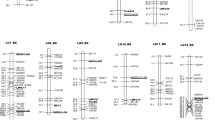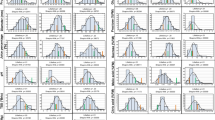Abstract
The progeny of 87 BC1 hybrids of ‘Murcott’ tangor and ‘Pêra’ sweet orange, genotyped with fluorescent amplified fragment length polymorphism (fAFLP) markers, was used for the construction of genetic maps for both citrus varieties. Mapping strategies, considering the progeny as a result of backcrossing and cross-pollination, were exploited in Mapmaker 2.0 (LOD score ≥ 3.0 and 9 ≤ 0.40) and JoinMap 3.0 software (LOD score ≥ 3.0 and 9 ≤ 0.25), respectively. Genetic map distances (in cM) between the linked fAFLPs were estimated, in both packages, by the Kosambi’s function. Maps of both parents were constructed in Mapmaker with 121 of the 202 fAFLP markers showing 1:1 Mendelian segregation rates (’Murcott’ map: 65 fAFLPs, average distance between them 29.5 cM, divided into 9 linkage groups (LGs), total size 1651.47 cM; ’Pêra’ map: 55 fAFLPs, average distance between them 31.9 cM, divided into 5 LGs, total size 1596.2 cM). The second ’Murcott’ map, constructed through linkage analysis of 347 fAFLP markers with 3:1 or 1:1 segregation rates by using JoinMap, resulted in the linkage of 227 markers with an average distance of 4.25 cM among them, divided into 9 LGs of 845 cM. fAFLP loci showing distorted segregation and/or clustered were observed in different LGs of the maps generated by all the software. The use of the ’Murcott’ tangor and ’Pêra’ sweet orange genetic maps in research on identification of citrus QRLs (quantitative resistance loci) toXylella fastidiosa and QTLs (quantitative trait loci) related to the productivity and quality of the juice, respectively, is discussed.
Similar content being viewed by others
References
Amaro AA, Maia ML, Gonzalez MA, 1997. Efeitos econômicos decorrentes da clorose variegada dos citros. In: Donadio LC, Moreira CS, eds. Clorose Variegada dos Citros, Bebedouro: 162.
Araújo EF, Queiroz LP, Machado MA, 2003. What isCitrus? Taxonomic implications from a study of cp-DNA evolution in the tribe Citreae (Rutaceae, subfamily Aurantioideae). Organisms Diversity Evolution 3: 55–62.
Ayres M, Ayres Júnior M, Ayres DL, Santos AS, 2000. BioEstat: aplicaçöes estatísticas nas áreas das ciências biológicas e médicas. Publicaçőes Avulsas Mamirauá. Belém/PA: Sociedade Civil Mamirauá: 272.
Baccarcia G, Albertini E, Tavoletti S, Falcinelli M, Veronesi F, 1999. AFLP fingerprinting inMedicago spp.: its development and application in linkage mapping. Plant Breeding 118: 335–340.
Bert PF, Charmet G, Sourdille P, Hayward MD, Balfourier F, 1999. A high-density molecular map for ryegrass (Loliumperenne) using AFLP markers. Theor Appl Genet 99: 445–452.
Buetow KH, 1991. Influence of aberrant observations on high-resolution linkage analysis outcomes. Am J Hum Genet 49: 985–994.
Cai Q, Guy CL, Moore GA, 1994. Extension of the linkage map inCitrus using random amplified polymorphic DNA (RAPD) markers and RFLP mapping of cold-acclimation-responsive loci. Theor Appl Genet 89: 606–614.
Castiglioni P, Ajmone-Marsan P, Van Wijk R Motto M, 1998. AFLP markers in a molecular linkage map of maize: codominant scoring and linkage group distribution. Theor Appl Genet 99: 425–431.
Chang CJ, Garnier M, Zreik L, Rossetti V, Bové JM, 1993. Culture and serological detection of the xylem-limited bacterium causing citrus variegated chlorosis and its identification as a strain ofXylella fastidiosa. Curr Microbiol 27: 137–142.
Cristofani M, Machado MA, Grattapaglia D, 1999. Genetic linkage maps ofCitrus sunki Hort. ex. Tan.and Poncirus trifoliata (L.) Raf. and mapping of citrus tristeza virus resistance gene. Euphytica 109: 25–32.
De Simone M, Russo MP, Puleo G, Marsan PA, Lorenzoni C, Marocco A, Recupero GR, 1998. Construction of genetic maps forCitrus aurantium andC. latipes based on AFLP, RAPD and RFLP markers. Fruits 53: 383–390.
Deng RE, Huang SY, Xiao S, Gmitter CM, 1997. Development and characterization of SCAR markers linked to the citrus tristeza virus resistance gene fromPoncirus trifoliata. Genome 40: 697–704.
Dettori MT, Quarta R, Verde I, 2001. A peach linkage map integrating RFLPs, SSRs, RAPDs, and morphological markers. Genome 44: 783–790.
Durham RE, Liou PC, Gmitter FG, Moore GA, 1992. Linkage of restriction fragment length polymorphisms and isozymes inCitrus. Theor Appl Genet 84: 39–48.
Fang DQ, Federici CT, Roose ML, 1997. Development of molecular markers linked to a gene controlling fruit acidity in citrus. Genome 40: 841–849.
Flament MH, Kebe I, Clément D, Pieretti I, Risterucci AM, ŃGoran JAK, Cilas C, 2001. Genetic mapping of resistance factors toPhytophthora palmivora in cocoa. Genome 44: 79–85.
Gadish I, Zamir D, 1986. Differential zygotic abortion in an interspecificLycopersicon cross. Genome 29: 156–159.
García R, Asíns MJ, Forner J, Carbonell EA, 1999. Genetic analysis of apomixis inCitrus and Poncirus by molecular markers. Theor Appl Genet 99: 511–518.
Garcia MR, Asns MJ, Carbonell EA, 2000. QTL analysis of yield and seed number inCitrus. Theor Appl Genet 101: 487–493.
Giovannoni JJ, Wing RA, Ganal MW, Tanksley SD, 1991. Isolation of molecular markers from specific chromosomal intervals using DNA pools from existing mapping populations. Nucl Acids Res 19: 6553–6558.
Gmitter Jr FG, Xiao SY, Huang S, Hu X.L, Garnsey SM, Deng Z, 1996. A localized linkage map of the citrus virus resistance gene region. Theor Appl Genet 92: 688–695.
Guerra M, 1993. Cytogenetics of Rutaceae. V. High chromosomal variability inCitrus species revealed by CMA/DAPI staining. Heredity 71: 234–241.
Heun M, Kennedy E, Anderson JA, Lapitan NLV, Sorrells ME, 1991. Construction of arestriction fragmentlength polymorphismmap for barley (Hordeum vulgare). Genome 34: 437–447.
Jarrell DC, Roose ML, Traugh SN, Kupper RS, 1992. A genetic maps ofCitrus based on the segregation of isozymes and RFLPs in an intergeneric cross. Theor Appl Genet 84: 49–56.
Kijas JMH, Thomas MR, Fowler JCS, Roose ML, 1997. Integration of trinucleotide microsatellites into a linkage map ofCitrus. Theor Appl Genet 94: 701–706.
Kosambi DD, 1944. The estimation of map distance from recombination values. Ann Eugen 12: 172–175.
Krutovskii KV, Vollmer SS, Soresen FC, Adams WT, Knapp SJ, Strauss SH, 1998. RAPD genome maps of Douglas-fir. JHered 3: 197–205.
Lander ES, Green P, Abrahamson J, Barlow A, Daly MJ, Lincoln SE, Newburg L, 1987. MAPMAKER: an interactive computer package for constructing primary genetic linkage maps of experimental and natural populations. Genomics 1: 174–181.
Laranjeira FF, Pompeu Jr J, Harakava R, Figueiredo JO, Carvalho AS, Coletta Filho HD, 1998. Cultivares e espécies cítricas hospedeiras deXylella fastidiosa em condiçôes de campo. Fitopatologia bras 23: 147–154.
Lespinasse D, Rodier-Goud M, Grivet L, Leconte A, Legnate H, Seguin MA, 2000. Saturated genetic linkage map of rubber tree (Hevea spp.) based on RFLP, AFLP, microsatellite, and isozyme markers. Theor Appl Genet 100: 127–138.
Ling P, Duncam LW, Deng Z, Dunn Z, Hu X, Huang S, Gmitter FG, 2000. Inheritance of citrus nematode resistance and its linkage with molecular markers. Theor Appl Genet 100: 1010–1017.
Liou PC, 1990. A molecular study of the citrus genome through restriction fragment length polymorphism and isozyme mapping. PhD thesis. University of Florida, Gainesville, FL: 143.
Lu ZX, Sosinski GL, Reighard WV, Baird WV, Abott AG, 1998. Construction of a genetic linkage map and identification of AFLP markers for resistance to root-knot nematodes in peach rootstocks. Genome 41: 199–207.
Luro F, Lorieux M, Laigret F, Bové JM, Ollitraut P, 1994. Genetic mapping of an intergeneric citrus hybrid using molecular markers. Fruits 49: 404–408.
Machado MA, Coletta Filho HD, Targon MLNP, Pompeu Juniror J, 1996. Genetic relationship of Mediterranean mandarins (Citrus deliciosa Tenore) using RAPD markers. Euphytica 92: 321–332.
Maliepaard C, Jansen J, van Ooijen JW, 1997. Linkage analysis in a full-sib family of an outbreeding plant species: overview and consequences for applications. Genet Res Camb 70: 236–250.
Nandi S, Subudhi PK, Senadhira D, Manigbas NL, Sen-Mandi S, Huang N, 1997. Mapping QTLs for submergence tolerance in rice by AFLP analysis and selective genotyping. Mol Gen Genet 255: 1–8.
Nienhuis J, Helentjaris T, Slocum M, Ruggero B, Schaefer A, 1987. Restriction fragment length polymorphism analysis of loci associated with insect resistance in tomato. Crop Sci 27: 797–803.
Nikaido A, Yoshimaru H, Tsumura Y, Suyama Y, Murai M, Nagasaka K, 1999. Segregation distortion for AFLP markers inCryptomeria japonica. Genes Genet Systems 74: 55–59.
Oliveira AC, Garcia AN, Cristofani M, Machado MA, 2002. Identification of citrus hybrids through the combinationof leaf apex morphology and SS Rmarkers. Euphytica 128: 397–403.
Oliveira AC, 2003. Clorose variegada dos citros: quantificação molecular do agente causal, avaliação de trocas gasosas de plantas infectadas e mapeamento de lócus de resistçncia quantitativa de citros àXylellafastidiosa Wells (1987) com fAFLPs. PhD thesis. Universidade Estadual de Campinas, Campinas, SP: 287.
Roose ML, Schwarzacher T, Heslop-Harrison J, 1998. The chromosomes ofCitrus andPoncirus species and hybrids: identification of characteristic chromosomes and physical mapping of rDNA loci using in situ hybridization and fluorochrome banding. J Hered 89: 83–86.
Roose ML, Jarrel DC, Kupper RS, 1992. Genetic mapping inCitrus Poncirus F2 population. Proc.Int.Soc. Citriculture 1: 210–213.
Ruiz C, Asins MJ, 2003. Comparison betweenPoncirus andCitrus genetic linkage maps. Theor Appl Genet 106: 826–836.
Sankar AA and Moore GA, 2001. Evaluation of inter-simple sequence repeat analysis for mapping in Citrus and extension of the linkage map. Theor Appl Gene 102: 206–214.
Shields DC, Collins A, Buetow KH, Morton NE, 1991. Error filtration, interference, and the human linkage map. Proc Natl Acad Sci USA 88: 6501–6505.
Soltis DE, Soltis PS, Doyle JJ, 1998. Molecular systematics of plants. II. DNA sequencing. Kluwer Academic Publishers. Norwell, Miss: 265–296.
Tozlu I, Guy CL, Moore GA, 1999a. QTL analysis of Na+ and Cl− accumulation-related traits in an intergeneric BC1 progeny ofCitrus andPoncirus under saline and nonsaline environments. Genome 42: 692–705.
Tozlu I, Guy CL, Moore GA, 1999b. QTL analysis of morphological traits in an intergeneric BC1 progeny ofCitrus andPoncirus under saline and nonsaline environments. Genome 42: 1020–1029.
Van Ooijen JW, Voorrips RE, 2001. Join MapTM version 3.0; software for the calculation of genetic linkage maps. Wageningen: Plant Res Internat 2001: 51.
Wells JM, Raju BC, Hung H, Weisburg WG, Mandelco-Paul L, Brenner DJ, 1987.Xylella fastidiosa gen. nov., sp. nov: gram-negative, xylem-limited, fastidious plant bacteria related toXanthomonas spp. Int J Syst Bacteriol 37: 136–143.
Zabeau M, 1993. Selective restriction fragment amplification: a general method for DNA fingerprinting. European Patent Application N 0534858 A1.
Zamir D, Tadmor Y, 1986. Unequal segregation of nuclear genes in plants. Bot Gaz 147: 355–358.
Author information
Authors and Affiliations
Corresponding author
Rights and permissions
About this article
Cite this article
de Oliveira, A.C., Bastianel, M., Cristofani-Yaly, M. et al. Development of genetic maps of the citrus varieties ‘Murcott’ tangor and ‘Pêra’ sweet orange by using fluorescent AFLP markers. J Appl Genet 48, 219–231 (2007). https://doi.org/10.1007/BF03195216
Received:
Accepted:
Issue Date:
DOI: https://doi.org/10.1007/BF03195216




